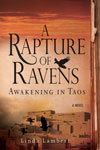« Community Leadership-Implications for Native Americans | Emerging Themes: Taos: Song of the Loom »
Larger than Chaco? Really? Hupobi Pueblo near Ojo Caliente
Last Wednesday, we drove from Taos to Pilar through the incredibly enchanting Rio Grande valley smothered with golden cottonwoods to the Pueblo site near Ojo Caliente hot springs. As we approached the last leg of the trip to the giant plateau, we found that what was once a road was now a river. A river—ok, more like a wide, rapidly moving stream—that we would have to cross on foot. All of us.
Once there, archaeologist Paulo, Carmen, Hannah and I met four teachers and 50 seventh graders from Santa Fe who were nearly gleeful to forge a river on foot. I was less than enthusiastic, but soon became preoccupied with the mountain of loose rocks that lay between us and the giant plateau pueblo—larger than Chaco Canyon! My concerns about crossing the river gave way to my trepidation about that perilous mountain. I find it personally amazing what one can do when l) there is no choice, and 2) I had a walking stick. The kids scrambled through the icy water, yelping as they went. They were inspiring! This was an adventure to be had, mysteries to be encountered—yet perhaps never to be solved.
As we topped the mesa, the most glorious site lay before us: the layout of a massive pueblo protruding through the soil like muscles rising through a wet tee shirt. A yawning indentation of a massive kiva. Just beyond, over the ledge of the once-village, the Rio Ojo Caliente snaked through the luxurious valley below. The kids swarmed over the land picking up chards of pottery, black on white (making sure to replace them carefully). On a higher hill still, the stone frames for dry farming punctuated the land (why didn’t they plant near the river? Security concerns?) .
On the south ledge of the plateau, multiple petroglyphs covered huge stones. Unlike anything I’d seen before: stars in all sizes and shapes. A few years ago, a woman archaeologist camped out here and discovered that the site aims directly at Venus, perhaps the inspiration for the designs. Most things make sense if we look hard enough…right?
Of course the most compelling questions for any abandoned pueblo, city, or land are: where did the inhabitants come from and why did they leave? Apparently, these industrious peoples came in the late 1100’s and left around 1500, probably when disease ravished the tribe (multiple burials during a certain period are excessive). Paulo believes that they came from the four corners: Mesa Verde and Chaco. If so—and if this could be more nearly proven—it could resolve one of the most mystifying issues of archaeology. The timing, pottery, location and dry farming could suggest as much. How to find out?
A glorious day!
Next: emerging themes in the Taos research….Linda
Leave a Reply





 Conceptions of leadership have evolved, and Liberating Leadership Capacity captures these new ideas and provides a pathway to create sustainable systems of high leadership capacity. Available April 2016 from
Conceptions of leadership have evolved, and Liberating Leadership Capacity captures these new ideas and provides a pathway to create sustainable systems of high leadership capacity. Available April 2016 from  A sizzling new novel set in Taos, New Mexico. The third in the Justine Trilogy, preceded by the award-winning, The Cairo Codex and The Italian Letters. Buy it at your local independent bookstore,
A sizzling new novel set in Taos, New Mexico. The third in the Justine Trilogy, preceded by the award-winning, The Cairo Codex and The Italian Letters. Buy it at your local independent bookstore, 
